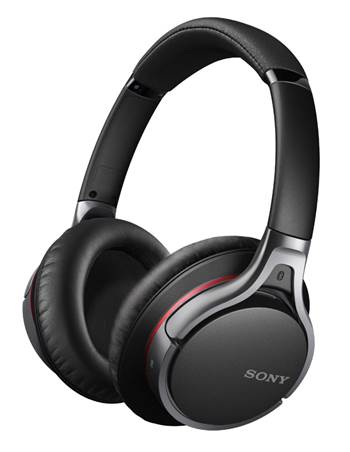Not the most exciting-looking cans, but they come from a
company that’s serious about audio again.
Having recently declared itself a hi-fi trendsetter, Sony
has unleashed a flurry of impressive-looking kit designed for hi-res audio.
Headphones aren’t just a part of the hi-res story and Sony’s headphone
credentials have long been established. The MDR-10RCs, while pitched at the
user of portable devices, are also well suited to use at home. The design is
more executive than streetwise, but the cans come in three color options for
those seeking a touch of individuality. The metal headband has a plastic underside
and is padded all round with a soft leather cover. The same luxurious material
is used on the 2cm-deep ring round the cups. The cups rotate slightly, and
combine with the right amount of twistability and arm extendability to make the
MDR-10RCs easy to adjust and slide into place on your head. Weighing under
170g, they are a very comfortable fit. They fold up and are supplied with a
cheapish pouch, plus you get two cables, one with an inline smartphone remote
(compatible with iOS, Android and BlackBerry device).

Sony MDR-10RC
Both cords are reasonably thick and have gold-plated
L-shaped plugs, which are less prone to damage than straight plugs. Overall,
although made of plastic they have a high-quality finish. Sony has used dynamic
40mm neodymium drivers with a closed-back design and claims the MDR-10RCs have
a dynamic range that spreads as low as 5Hz up to a canine-compatible 40kHz.
Sound quality
Kicking off with The War Of The Worlds SACD, the MDR-10RCs
show themselves to be razor sharp, with a tight, highly articulate sound with
the midrange and upper end of the scale. There’s plenty of bass, but it doesn’t
have the same level of refinement with longer notes that drop off and become a
bit flabby. Track two, Horsell Common And The Heat Ray, starts with a short,
repeated bass phrase that the Sony keeps a decent handle on and the cylinder
unscrewing creates an impressively broad and high soundstage.

Sony MDR-10RC
The first two minutes of the The Lark Ascending bring out
the best of the MDR-10RC, showing its almost unrivaled ability with higher
frequencies. There’s a purity and smoothness to proceedings with the violin’s
high notes given plenty of headroom. The horn at three minutes in is also
exquisitely precise, but as the orchestra joins in and the piece builds to a
crescendo the cans almost lose control of the lengthy bass notes. The short
snappy drum beats of Listingby Minus The Bear are much better fodder, providing
the vocals, percussion and guitars with the perfect canvas as the headphones
reveal their energetic quality. The Sonys pass the tricky piano test at the
start of Snowed In At Wheeler Street, played through the Musical Fidelity
headphone amp.
As the pianist slams down the keys there’s no distortion,
but later as Elton John sings the cans trip up with an impending sense of
reverberation. The vocal presentation, however, is first rate from both singers
and the synth is svelte and elegant.

Sony MDR-10RC
The MDR-10RCs certainly seem to get more out of the drum in
Bob Marley’s Could You Be Loved, which has a greater sense of air around it
when compared to many other cans that sound a bit flat in this regard. The
MDR-10RCs seem to dig a bit deeper than its rivals here, but isn’t always able
to keep a tight grip on matters when it does. Otherwise, these are enjoyable
cans to own and use with good dynamics and detail.
On Test
Sony claims a sensitivity of 100dB SPL for 1mW for the
MDR-10RC, equivalent to 114dB SPL for 1V input at the nominal impedance of
40ohms. This accords pretty well with our measured figure of 112.8dB at 1kHz,
although the higher impedance – we recorded a minimum of 41.2ohms at 20Hz and a
maximum of 47.7ohms at 2.2kHz – inevitably means slightly lower sensitivity
than with the 32ohms models here. Frequency response change resulting from that
variation in impedance is negligible at 0.2dB for a 10ohm source and 0.5dB for
a 30ohm source. Sony promises ‘heavy-hitting bass’ from the MDR-10C, meaning LF
excess – albeit not quite to match the H/K’s. The diffuse-field-corrected
response peaks at about +11dB at 80Hz ref 1kHz but, again in common with the
Soho, is much flatter at treble frequencies. Bass extension is fair at 28Hz, as
is the capsule matching error of ±5.0dB.
|
Specifications
·
Price: $246
·
Product: Sony MDR-10RC
·
Origin: China
·
Type: Closed back, on-ear headphones
·
Weight: 165g
·
40mm driver
·
Thin metal headband, covered in hard plastic and a padded
leather wraparound
·
1.2m connecting cord
Verdict
·
Sound quality: 4/5
·
Value for money: 4.5/5
·
Build quality: 5/5
·
Features: 4/5
|